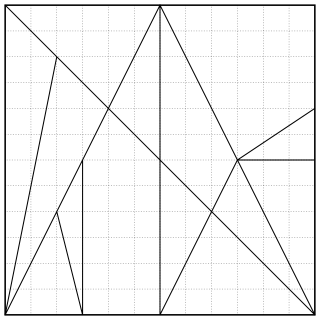
Priscianus Caesariensis, commonly known as Priscian, was a Latin grammarian and the author of the Institutes of Grammar, which was the standard textbook for the study of Latin during the Middle Ages. It also provided the raw material for the field of speculative grammar.

Servius, distinguished as Servius the Grammarian, was a late fourth-century and early fifth-century grammarian. He earned a contemporary reputation as the most learned man of his generation in Italy; he authored a set of commentaries on the works of Virgil. These works, In Tria Virgilii Opera Expositio, Commentarii in Virgilium, Commentarii in Vergilii Opera, or Vergilii Carmina Commentarii, constituted the first incunable to be printed at Florence, by Bernardo Cennini, in 1471.
Quintus Remmius Palaemon or Quintus Rhemnius Fannius Palaemon was a Roman grammarian and a native of Vicentia. He lived during the reigns of Emperors Tiberius and Claudius.
Aelius Festus Aphthonius is believed to be the author of a Latin work called De metris omnibus incorporated as part of the Ars Grammatica of the fourth-century AD Christian writer Gaius Marius Victorinus.
Quintus Terentius Scaurus was a Latin grammarian who flourished during the reigns of Trajan and Hadrian.
Flavius Sosipater Charisius was a Latin grammarian.
Aemilius Asper, Latin grammarian, possibly lived in the 1st century AD or late 2nd century AD.
Publius Consentius was a 5th-century Latin grammarian and the author of two treatises, which are perhaps the fragments of a complete grammar: Ars de duabus partibus orationis, nomine et verbo, on the noun and the verb, which was much used during the Carolingian period, and Ars de barbarismis et metaplasmis, on barbarisms and metaplasm. The latter refers to a third essay, De structurarum ratione, on the structure of sentences, which, if ever published, no longer exists.
Gaius Marius Victorinus was a Roman grammarian, rhetorician and Neoplatonic philosopher. Victorinus was African by birth and experienced the height of his career during the reign of Constantius II. He is also known for translating two of Aristotle's books from ancient Greek into Latin: the Categories and On Interpretation. Victorinus had a religious conversion, from being a pagan to a Christian, "at an advanced old age".
Virgilius Maro Grammaticus, known in English as Virgil the Grammarian or Virgil of Toulouse, is the author of two early medieval grammatical texts known as the Epitomae and the Epistolae.
Dositheus Magister was a Greek grammarian who flourished in Rome in the 4th century AD.
Diomedes Grammaticus was a Latin grammarian who probably lived in the late 4th century AD. He wrote a grammatical treatise, known either as De Oratione et Partibus Orationis et Vario Genere Metrorum libri III or Ars grammatica in three books, dedicated to a certain Athanasius. Since he is frequently quoted by Priscian, he must have lived before the year 500. His third book on poetry is particularly valuable, containing extracts from Suetonius's De poetica. This book contains one of the most complete lists of types of dactylic hexameters in antiquity, including the teres versus, which may be the so-called "golden line." Diomedes wrote about the same time as Charisius and used the same sources independently. The works of both grammarians are valuable, but whereas much of Charisius has been lost, the Ars of Diomedes has come down to us complete. In book I he discusses the eight parts of speech; in II the elementary ideas of grammar and of style; in III poetry, quantity, and meters. The best edition is in H. Keil's Grammatici Latini, vol I.

Ostomachion, also known as loculus Archimedius or syntomachion, is a mathematical treatise attributed to Archimedes. This work has survived fragmentarily in an Arabic version and a copy, the Archimedes Palimpsest, of the original ancient Greek text made in Byzantine times.
Atilius Fortunatianus was a Latin grammarian. He was the author of a treatise on metres, dedicated to one of his pupils, a youth of senatorial rank, who desired to be instructed in the Horatian metres. The manual opens with a discussion of the fundamental ideas of metre and the chief rules of prosody, and ends with a detailed analysis of the metres of Horace. The chief authorities used are Caesius Bassus and the Latin adaptation by Juba the grammarian of the Τέχνη of Heliodorus. Fortunatianus being a common name in the African provinces, it is probable that the author was a countryman of Juba, Terentianus Maurus and Victorinus.
The Ars Bonifacii is the title given to a Latin grammar ascribed to Saint Boniface.
The gens Velia was a minor plebeian family at ancient Rome. Members of this gens are first mentioned in the latter part of the first century AD. The first of the Velii to obtain the consulship was Decimus Velius Fidus in AD 144.
Marius Plotius Sacerdos was a Roman grammarian who flourished towards the end of the third century CE. He wrote an ars grammatica in three books, the third of which treats of meter.
De vita sua is an autobiography written by Marcus Aemilius Scaurus, a prominent statesman of the Roman Republic, notably consul in 115 BC and princeps senatus for a generation. Even though the book is lost and has only survived in seven small fragments, it is the first known autobiography in Roman history. Scaurus wrote his autobiography in order to defend his actions throughout his long career, during which he was at the centre of Roman politics, from the tribunates of Gaius Gracchus to the Social War, and engaged in bitter feuds with numerous enemies. Most scholars think that Scaurus wrote the autobiography towards the end of his life.
Pompeius Grammaticus, also known as Pompeius the Grammarian, was a Latin grammarian of the fifth century, author of a Commentary on Donatus's grammar.
A grammar book is a book or treatise describing the grammar of one or more languages. Such books are themselves frequently referred to as grammars.



